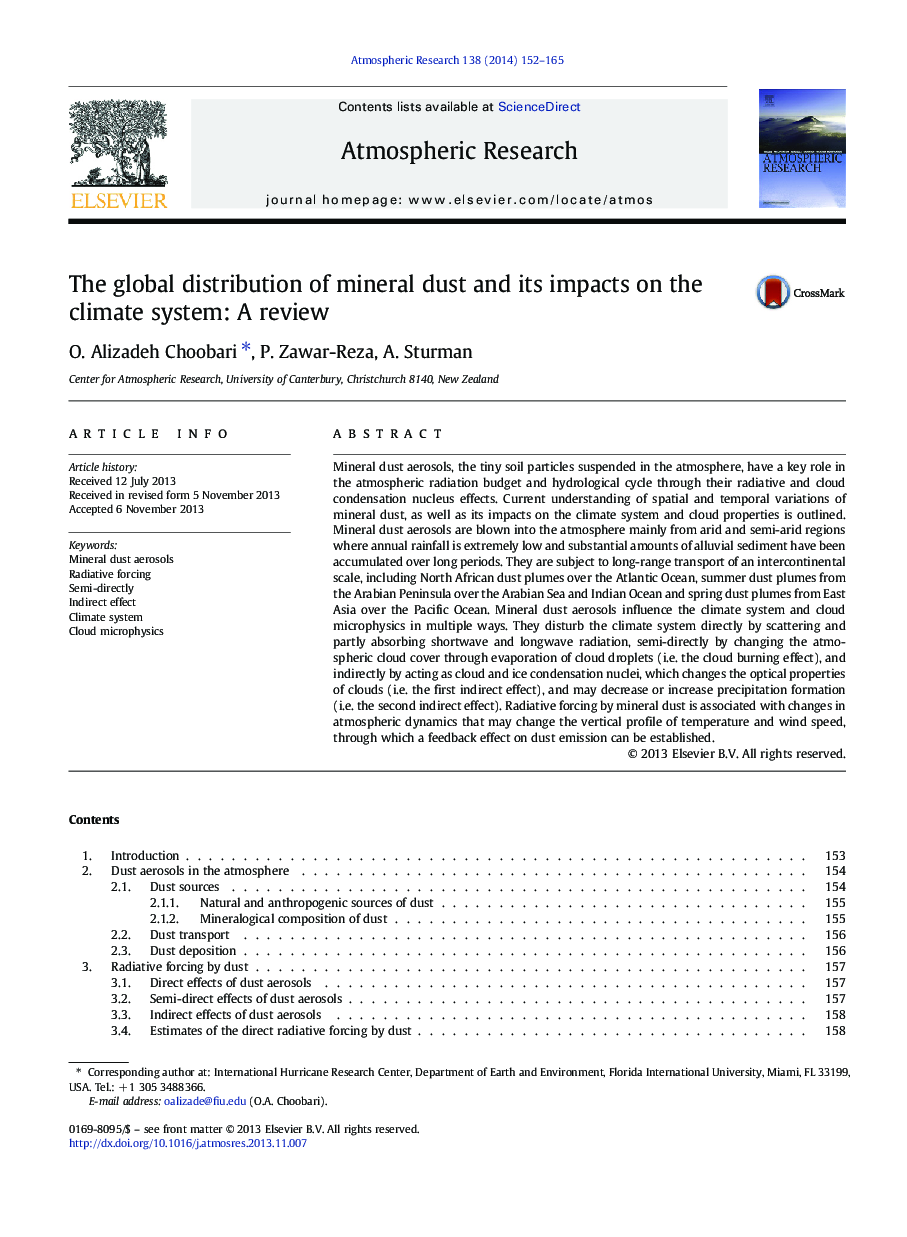| کد مقاله | کد نشریه | سال انتشار | مقاله انگلیسی | نسخه تمام متن |
|---|---|---|---|---|
| 6343632 | 1620532 | 2014 | 14 صفحه PDF | دانلود رایگان |
عنوان انگلیسی مقاله ISI
The global distribution of mineral dust and its impacts on the climate system: A review
ترجمه فارسی عنوان
توزیع جهانی گرد و غبار معدنی و اثرات آن بر سیستم آب و هوا: بررسی
دانلود مقاله + سفارش ترجمه
دانلود مقاله ISI انگلیسی
رایگان برای ایرانیان
کلمات کلیدی
آلیزهای گرد و غبار معدنی، اعمال تابشی، نیمه مستقیم، اثر غیر مستقیم، سیستم آب و هوا، ابر میکرو فیزیک،
ترجمه چکیده
آلیزهای گرد و غبار معدنی، ذرات کوچک خاکی که در جو ذوب می شوند، نقش کلیدی در بودجه تابش جوی و چرخه هیدرولوژیکی را از طریق اثرات هسته ای اشباع شعاعی و ابرشان ایفا می کنند. درک کنونی تغییرات مکانی و زمانی گرد و غبار معدنی، و همچنین اثرات آن بر سیستم آب و هوا و خواص ابر مشخص شده است. اسپری های گرد و غبار معدنی به طور عمده از مناطق خشک و نیمه خشک که در آنها بارندگی سالانه بسیار کم است و مقدار قابل توجهی رسوبات آبرفتی در طی مدت طولانی انباشته شده است، نفوذ می کند. آنها حمل و نقل طولانی مدت مقیاس بین قاره ای، از جمله گرد و غبار شمال غربی در سرتاسر اقیانوس اطلس، تابش های گرد و غبار تابستانی از شبه جزیره عربستان در امتداد دریای عربی و اقیانوس هند و در معرض گرد و غبار گرد و غبار از شرق آسیا در اقیانوس آرام است. اسپری های گرد و غبار معدنی بر سیستم آب و هوا و میکرو فیزیک ابر تاثیر می گذارند. آنها سیستم مستقیم آب و هوا را با پراکندگی و تا حدی جذب تابش های کوتاه مدت و طوفان طولانی، به طور نیمه مستقیم با تغییر سطح ابر اتمسفر از طریق تبخیر قطرات ابر (یعنی اثر سوختگی ابر)، و به طور غیر مستقیم به عنوان ابر و هسته چگالی یخ که خواص نوری ابرها (یعنی اولین اثر غیر مستقیم)، و ممکن است کاهش یا افزایش بارش (یعنی اثر دوم غیر مستقیم) را تغییر دهد. تابش اشباع شده توسط گرد و غبار معدنی با تغییرات دینامیکی اتمسفر همراه است که می تواند مشخصات عمودی دما و سرعت باد را تغییر دهد که از طریق آن اثر بازخوردی بر انتشار گرد و غبار ایجاد می شود.
موضوعات مرتبط
مهندسی و علوم پایه
علوم زمین و سیارات
علم هواشناسی
چکیده انگلیسی
Mineral dust aerosols, the tiny soil particles suspended in the atmosphere, have a key role in the atmospheric radiation budget and hydrological cycle through their radiative and cloud condensation nucleus effects. Current understanding of spatial and temporal variations of mineral dust, as well as its impacts on the climate system and cloud properties is outlined. Mineral dust aerosols are blown into the atmosphere mainly from arid and semi-arid regions where annual rainfall is extremely low and substantial amounts of alluvial sediment have been accumulated over long periods. They are subject to long-range transport of an intercontinental scale, including North African dust plumes over the Atlantic Ocean, summer dust plumes from the Arabian Peninsula over the Arabian Sea and Indian Ocean and spring dust plumes from East Asia over the Pacific Ocean. Mineral dust aerosols influence the climate system and cloud microphysics in multiple ways. They disturb the climate system directly by scattering and partly absorbing shortwave and longwave radiation, semi-directly by changing the atmospheric cloud cover through evaporation of cloud droplets (i.e. the cloud burning effect), and indirectly by acting as cloud and ice condensation nuclei, which changes the optical properties of clouds (i.e. the first indirect effect), and may decrease or increase precipitation formation (i.e. the second indirect effect). Radiative forcing by mineral dust is associated with changes in atmospheric dynamics that may change the vertical profile of temperature and wind speed, through which a feedback effect on dust emission can be established.
ناشر
Database: Elsevier - ScienceDirect (ساینس دایرکت)
Journal: Atmospheric Research - Volume 138, 1 March 2014, Pages 152-165
Journal: Atmospheric Research - Volume 138, 1 March 2014, Pages 152-165
نویسندگان
O. Alizadeh Choobari, P. Zawar-Reza, A. Sturman,
